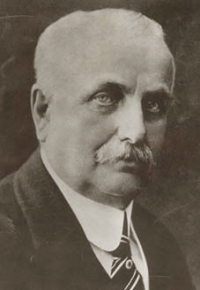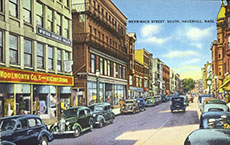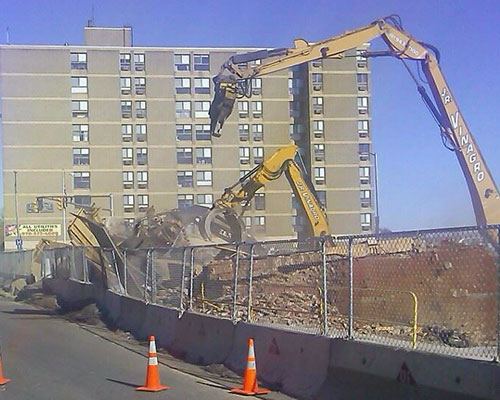Demolition photographs courtesy of Steven Zins.
The former F. W. (Frank Winfield) Woolworth Building on Merrimack Street is no more.
It came down late Thursday afternoon to make way for the $68 million Harbor Place development. A four-story commercial building is planned to take its place at White’s Corner—Merrimack and Bridge Streets. UMass—Lowell is expected to take two floors and Pentucket Bank one floor for its executive offices. At street level, developers expect a restaurant or other retail space and a satellite recording studio for Haverhill Community Television. Next door, 80 units of housing is planned.
Bank of America is providing a $25 million construction loan and $13 million in equity financing through the purchase of tax credits, while Haverhill Bank and Pentucket Bank are providing additional financing, developers previously reported.
Boston Archdiocese’s Planning Office for Urban Affairs, Greater Haverhill Foundation and Boston attorney Frank Giso III form the development consortium. Everything on the south side of the street between Basiliere Bridge and the Landmark Building (formerly Mitchell’s department store), except for Lahey Health Behavioral Services, 60 Merrimack St., is owned or controlled by the group.
Greater Haverhill Foundation purchased the vacant department store Dec. 19, 2005 for $1.4 million. However, immediate reuse plans collapsed when at least one adjacent property owner reportedly balked at the proposed price offered to him. The Great Recession of 2008 furthered hampered plans, but later resulted in falling property values and escalation of development plans. Early in 2013, the foundation sold Woolworth’s into the consortium for $1,087,410, kicking off what would be called Harbor Place.
Woolworth’s 1940s Construction Also Met Delays

Frank Winfield Woolworth (April 13, 1852 – April 8, 1919), founder of F. W. Woolworth Company.
Construction of the original F. W. Woolworth Company Five-and-Dime store at that location in 1949 was, itself, a long, drawn-out procedure.
As early as Feb. 7, 1944, the F. W. Woolworth Co. of New York leased the property at 2-14 Merrimack St. from New Bedford Realty Corp of Somerville. New Bedford Realty Corp. received a mortgage from the former City Savings Bank (now part of Pentucket Bank) nine days later when the bank’s board authorized its treasurer, William J. Morgan, to draw up the papers.
The company already operated a store further up Merrimack Street, but the new store promised to bring the chain’s now-signature appearance to the city.
Problems began when neighboring property owners went to Land Court to protect their right-of-way to an alley at the right of the proposed structure. Frank Freeman, Evelyn W. Brook, Henry W. Merrill and the estates of George C. Wadleigh and Perley Leslie sought to ensure the alley between Merrimack and Wall Streets “shall forever remain open to the sky.” The court blessed a stipulation between the parties Feb. 16, 1945.

Haverhill’s original F.W. Woolworth Co. store on Merrimack Street.
“In the event of the construction of a new building on the above lot, the said passageway shall be left the same size and dimensions as the existing passageway,” the stipulation said. Familiar Haverhill names were involved in negotiations, including Attorney John Bradford Davis, representing the Leslie estate, and James P. Cleary, representing Freeman.
More than a year later, on June 24, 1946, New Bedford Realty Corp. scuttled the lease agreement altogether and sold the property outright to Woolworth’s.
Land Court records are not clear, but William A. Conte of Haverhill later gained control of the property. After Woolworth’s closed in 1969, the property remained vacant except for brief period of time when it was occupied by a used goods store, Consignment World.
Upon Conte’s passing in 1993 and a long probate case, the property eventually landed in the hands of his heirs, Jessie B. Conte and Ronda Conte Cretarolo.
Going…

Going…

Gone.


conte was a cancer on Haverhill just like a sitting city councilor is a huge slumlord
The story is interesting, and raises the question about how Mr Conte got his hands on the property. City lore has it that when he got control, he worked out a multi year lease of the property back to Woolworth’s. Why the City had no means to force the sale of the property after it became an eyesore right in the heart of the city I will never understand.
Let it be said that the famous or if you choose infamous Mr Conte was a wheeler dealer at worst.
Very interesting information.